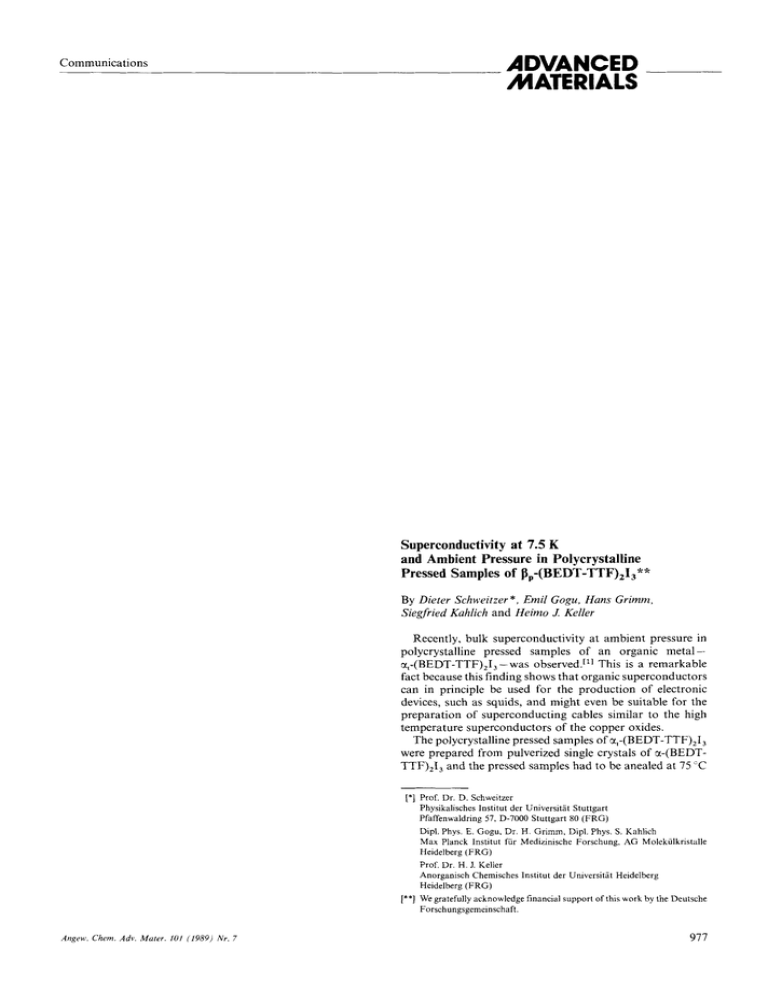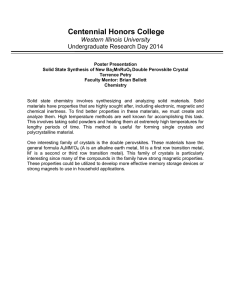p-(BEDT-TTF)
advertisement

ADVANCED MATERIALS Communications Superconductivity at 7.5 K and Ambient Pressure in Polycrystalline Pressed Samples of f$-(BEDT-TTF),13** By Dieter Schweitzer *, Emil Gogu, Hans Grimm, Siegfiried Kahlich and Heimo J. Keller Recently, bulk superconductivity at ambient pressure in polycrystalline pressed samples of an organic metal a,-(BEDT-TTF),I, - was observed."' This is a remarkable fact because this finding shows that organic superconductors can in principle be used for the production of electronic devices, such as squids, and might even be suitable for the preparation of superconducting cables similar to the high temperature superconductors of the copper oxides. The polycrystalline pressed samples of a,-(BEDT-TTF),I, were prepared from pulverized single crystals of a-(BEDTTTF),13 and the pressed samples had to be anealed at 75 "C ["I [**I Angew. Chem. Adv. Muter. 101 (1989) Nr. 7 Prof Dr D Schweitzer Physikalisches Institut der Universitdt Stuttgdrt Pfaffenwaldring 57, D-7000 Stuttgart 80 (FRG) D ~ p lPhys E Gogu, Dr H Grimm, Dip1 Phys S Kahlich Max Pldnck Institut fur Medizinische Forschung, AG Molekulkrist~lle Heidelberg (FRG) Prof Dr H J Keller Anorganisch Chemisches lnstitut der Universitdt Heidelberg Heidelberg (FRG) We gratefully acknowledge financial support of this work by the Deutsche Forschungsgememschaft 977 ADVANCED MATERIALS for one or two days in order to obtain the a,-phase and to observe bulk superconductivity with an onset temperature of about 9 K.['] Nevertheless, the superconducting transition was rather broad with respect to single crystals of a,-(BEDTTTF),I, and zero resistivity was found at 2.2 K. On the other hand, single crystals of (BEDT-TTF),Cu(NCS), show the highest transition temperature known so far among the organic superconductors of 10.4 K,i2]although no bulk superconductivity could be found."] The reason for the loss of the bulk superconductivity in the polycrystalline pressed sample compared to the single crystals of (BEDT-TTF),Cu(NCS), is not quite clear, but is probably due to a phase transition of the material during the preparation of the sample under pressure. Here we report the surprising fact that polycrystalline pressed samples of P-(BEDT-TTF),I, show bulk superconductivity with an onset temperature to superconductivity of 9 K, zero resistivity at 3.2 K and the middle of the resistive transition at 7.5 K. In contrast to the polycrystalline samples, single crystals of P-(BEDT-TTF),I, show a rather sharp superconducting transition but only at 1.4 K (onset temperature 1.6 K).[31Under an isotropic pressure of about 1 kbar the single crystals of b-(BEDT-TTF),I, show a superconducting transition at 7.5 K.14,51 After a pressure-temperature cycling procedure, pressurizing the crystal up to 1 kbar at room temperature and then releasing the helium gas pressure at temperatures below 125 K, superconductivity at 8 K and ambient pressure in P-(BEDT-TTF),I, was found.[', 'I However, this specially prepared superconducting state at 8 K and ambient pressure is metastable because superconductivity at 8 K can only be obtained as long as the temperature of the single crystals does not exceed 125 K. It is therefore very surprising that in the polycrystalline pressed samples of P-(BEDT-TTF),I, a stable superconducting state with an onset temperature of 9 K at ambient pressure exists. For this reason we term the polycrystalline pressed samples of the P-phase P,-(BEDT-TTF),I,, where the index p indicates the polycrystalline pressed material. Samples of the size 4 x 1 x 0.5 mm3 were prepared from pulverized single crystals of P-(BEDT-TTF),I, (the resulting crystallites from the graining process had typical diameters of 0.1 -10 pm) by applying a pressure of about 1.5 . lo4 kg/ cm2 to the powder. The Po-(BEDT-TTF),I, samples pre- ' P [Rcml 0.08t d B (polycryst p r e s s e d sample) TlKl - Fig. 1. Temperature dependence of the resistivity of polycrystalline pressed samples of 0,-(BEDT-TTF),I, and a,-(BEDT-TTF),I,. 978 Communications pared in this way are mechanically very stable and were not tempered as in the case of the previously reported pressed samples of a,-(BEDT-TTF),I, . The conductivity was measured with the usual four point method. Typical room temlie between 5 and 10 (0cm)-' perature conductivities 0 3 0 0 and are about a factor of 2 lower than in the polycrystalline pressed samples of a,-(BEDT-TTF),I,. Figure 1 shows the typical temperature dependence of the resistivity of polycrystalline pressed samples of P,-(BEDT-TTF),I, as well as of a,-(BEDT-TTF),I,. It can clearly be seen that the resistivity characteristics of the samples of P,-(BEDT-TTF),I, differ remarkably from those of a,-(BEDT-TTF),I, samples (and in fact also from the resistivity characteristics of single crystals of P-(BEDT-TTF),I,).[81 While in the a,-samples the resistivity decreases as it does in a metal as the sample is cooled from room temperature, in the case of the P,-(BEDTTTF),I, samples the resistivity first increases slowly on lowering the temperature. At around 220 K, the temperature at which an incommensurate structural modulation in single crystals of P-(BEDT-TTF),I, occurs,[91a maximum in resistivity is observed, and below 220 K again as in a metal the resistivity decreases. Figure 2 shows the resistivity of P,-(BEDT-TTF),I, samples in the temperature range below 16 K. As can be seen the 0.016 I ~,-(BEOT-TTF),I, lpolycryst p r e s s e d s a m p l e ) I I P [Rcml 0 012 0.010. p' P 0 008- 0 006 - 0 2 1 6 8 T[KI - 10 12 11 Fig. 2 . Temperature dependence of the resistivity of polycrystalline pressed samples of P,-(BEDT-TTF),I, in the temperature range below 16 K. onset of superconductivity lies at around 9 K and zero resistivity is found below 3.2 K indicating a rather broad transition. Nevertheless, the middle of the resistive transition is at around 7.5 K. The onset temperature for superconductivity here in P,-(BEDT-TTF),I, is much higher than that in the single crystals of p-(BEDT-TTF),I, . The reason for this is not yet clear, but the material probably undergoes a phase transition during the preparation of the polycrystalline samples under pressure. On the other hand, it is clear that the new &-phase is not identical with the known a,-phase indicated by their different resistivity characteristics. In addition, first measurements of the upper critical fields H,, have shown that the polycrystalline pressed samples of the b,- and a,-phases have different upper critical fields H,, ,[lo] but these are in both cases much higher than the upper critical field H,, in crystals of a,-(BEDT-TTF),I, .[''I In order to obtain information on whether the observed superconductivity is a bulk effect of the sample or not, the Angew. Chem. Adv. Maler. I01 (1989) N r . 7 ADVANCED MATERIALS Communications AC susceptibility was measured at a frequency of 3 MHz with a field of about 0.2 Gauss. Figure 3 shows the increase in the resonance frequency of the LC-circuit due to exclusion of the RF-field by diamagnetic shielding currents in the polycrystalline pressed sample of p,-(BEDT-TTF),I,. There is clear evidence of an onset of diamagnetic shielding below 6 K (in samples of a,-(BEDT-TTF),I, below 7 K). Here in the polycrystalline sample the onset for the diamagnetic shielding is Far above the temperature where the resistivity becomes zero as is usually observed in single crystals of organic superconductors. The signal in Figure 3 which still p,-(BEDT-TTF)213 lpolycryst p r e s s e d sample) t 1 6vlkHz 1 It should be mentioned that tempering of the polycrystalline pressed samples of P,-(BEDT-TTF),I, for one or two days at 75 to 90°C (as in the case of the samples of a,(BEDT-TTF),I,) does not change the physical properties of the samples. In conclusion, superconductivity at ambient pressure and 7.5 K exists in samples of p,-(BEDT-TTF),I,. The superconducting state is stable and the superconductivity is a bulk effect of the sample. Similar to the polycrystalline samples of q-(BEDT-TTF),I, here again structural phase transitions during the preparation of the samples under pressure seem to play an important role. As a consequence of the structural phase transition, here in P,-(BEDT-TTF),I,, the transition temperature into the superconducting state is increased. This behavior reemphasizes that organic superconductors might also be of interest for industrial applications, as in the preparation of electronic devices polycrystalline materials are easier to use than single crystals. In addition, the discovery of bulk superconductivity in large pressed samples of crystallites of an organic metal of the typical diameter of 1 pm indicates that the observation of superconductivity in conducting polymers should also be possible. Received: March 13. 1989 T lK1 - Fig. 3. Increase of the resonance frequency of an LC-circuit (3 MHz) due to exclusion of the RF-field by diamagnetic shielding currents (AC susceptibility) in a polycrystalline pressed sample of !3,-(BEDT-TTF),13 caused by cooling the sample from 10 K down to 2 K. increases on cooling down to 2 K, corresponds to about 50 % that expected for a perfect superconductor, indicating a clear bulk effect on the superconductivity in the polycrystalline pressed p,-(BEDT-TTF),I, samples. Nevertheless, the large temperature range in which the frequency shift of the resonance frequency is observed shows that an inhomogeneous distribution of superconducting transitions exists in the sample. A similar broad distribution was already observed in the case of the polycrystalline pressed samples of a,-(BEDT-TTF),I,. Angew. Chem. Adv. Maler. 101 (1989) Nr. 7 [l] D. Schweitzer, S. Gartner, H. Grimm, E. Gogu, H. J. Keller, Solid Stare Commun. 69 (1989) 843. [2] H. Urayama, H. Yamochi, G. Saito, K. Nozawa, T. Sugano, M. Kinoshita. S. Saito, K. Oshima, A. Kawamoto, J. Tanaka; Chem. Lett. 1988 617. [3] E. B. Yagupskii, I. E Shegolev, V. N. Laukhin, P. A. Kononovich, M. V. Kartsovuik, A. V. Zwarykina, L. I. Buravov; Sov. Phys. JETP Lert. 39 (1984) 12. 141 K. Murata, M. Tokumoto, H. Anzai, H. Bando, G. Saito, K. Jajimura, T. ’ Ishiguro; J Phys. Soc. Jpn. 54 (1985) 1236. [ S ] V. N. Laukhin, E. E. Kostyuchenko, Yu. V. Sushko, 1. F. Shegolev E. B. Yagupskii, Sov. Phys. JETP Lett. 41 (1985) 81. [6] F. Creuzet, G. Creuzet, D. JCrome, D. Schweitzer, H. J. Keller, J Phys. (Paris) Lett. 46 (1985) L-1079. [7] F. Creuzet, D. Jkrome, D. Schweitzer, H. J. Keller, Europhys. Lert. I(1986) 461. [8] M. Weger, K. Bender, T. Klutz, D. Schweitzer, F. Gross, C. P. Heidmann, C. Probst, K. Andres, Synth. Metals 25 (1988) 49. [9] P. C. W Leung, T. J. Emge, M. A. Beno, H. H. Wang, J. M. Williams, J Am. Chem. Soc. 106 (1984) 7644. [lo] E. Gogu, D. Schweitzer, H. J. Keller, unpublished. [ l l ] E. Gogu, D. Schweitzer, H. J. Keller; Physica C 1 5 3 - 155 (1988) 491. 979


